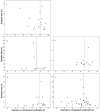Criterion-Related Validity of the Distance- and Time-Based Walk/Run Field Tests for Estimating Cardiorespiratory Fitness: A Systematic Review and Meta-Analysis
- PMID: 26987118
- PMCID: PMC4795745
- DOI: 10.1371/journal.pone.0151671
Criterion-Related Validity of the Distance- and Time-Based Walk/Run Field Tests for Estimating Cardiorespiratory Fitness: A Systematic Review and Meta-Analysis
Abstract
Objectives: The main purpose of the present meta-analysis was to examine the criterion-related validity of the distance- and time-based walk/run tests for estimating cardiorespiratory fitness among apparently healthy children and adults.
Materials and methods: Relevant studies were searched from seven electronic bibliographic databases up to August 2015 and through other sources. The Hunter-Schmidt's psychometric meta-analysis approach was conducted to estimate the population criterion-related validity of the following walk/run tests: 5,000 m, 3 miles, 2 miles, 3,000 m, 1.5 miles, 1 mile, 1,000 m, ½ mile, 600 m, 600 yd, ¼ mile, 15 min, 12 min, 9 min, and 6 min.
Results: From the 123 included studies, a total of 200 correlation values were analyzed. The overall results showed that the criterion-related validity of the walk/run tests for estimating maximum oxygen uptake ranged from low to moderate (rp = 0.42-0.79), with the 1.5 mile (rp = 0.79, 0.73-0.85) and 12 min walk/run tests (rp = 0.78, 0.72-0.83) having the higher criterion-related validity for distance- and time-based field tests, respectively. The present meta-analysis also showed that sex, age and maximum oxygen uptake level do not seem to affect the criterion-related validity of the walk/run tests.
Conclusions: When the evaluation of an individual's maximum oxygen uptake attained during a laboratory test is not feasible, the 1.5 mile and 12 min walk/run tests represent useful alternatives for estimating cardiorespiratory fitness. As in the assessment with any physical fitness field test, evaluators must be aware that the performance score of the walk/run field tests is simply an estimation and not a direct measure of cardiorespiratory fitness.
Conflict of interest statement
Figures



Similar articles
-
Physical exercise training interventions for children and young adults during and after treatment for childhood cancer.Cochrane Database Syst Rev. 2016 Mar 31;3(3):CD008796. doi: 10.1002/14651858.CD008796.pub3. Cochrane Database Syst Rev. 2016. PMID: 27030386 Free PMC article.
-
A Method by Which to Assess the Scalability of Field-Based Fitness Tests of Cardiorespiratory Fitness Among Schoolchildren.Sports Med. 2016 Dec;46(12):1819-1831. doi: 10.1007/s40279-016-0553-6. Sports Med. 2016. PMID: 27229897 Free PMC article.
-
Criterion-related validity of field-based fitness tests in youth: a systematic review.Br J Sports Med. 2010 Oct;44(13):934-43. doi: 10.1136/bjsm.2009.058321. Epub 2009 Apr 12. Br J Sports Med. 2010. PMID: 19364756
-
Criterion-Related Validity of the 20-M Shuttle Run Test for Estimating Cardiorespiratory Fitness: A Meta-Analysis.J Sports Sci Med. 2015 Aug 11;14(3):536-47. eCollection 2015 Sep. J Sports Sci Med. 2015. PMID: 26336340 Free PMC article. Review.
-
Return to Running After Achilles Tendon Repair: How Do US Navy Service Members' Physical Readiness Tests Change After Undergoing an Achilles Tendon Repair?Clin Orthop Relat Res. 2025 Jun 18. doi: 10.1097/CORR.0000000000003590. Online ahead of print. Clin Orthop Relat Res. 2025. PMID: 40536551
Cited by
-
Cardiorespiratory Fitness and Its Place in Medicine.Rev Cardiovasc Med. 2023 Jan 6;24(1):14. doi: 10.31083/j.rcm2401014. eCollection 2023 Jan. Rev Cardiovasc Med. 2023. PMID: 39076861 Free PMC article. Review.
-
Increase in peak oxygen uptake and Andersen test performance in children from age six to ten: The Health Oriented Pedagogical Project (HOPP).Front Physiol. 2022 Sep 29;13:976505. doi: 10.3389/fphys.2022.976505. eCollection 2022. Front Physiol. 2022. PMID: 36246119 Free PMC article.
-
Impact of fitness coach behavior on exercise motivation, commitment, and enjoyment: A longitudinal study.PLoS One. 2024 Dec 30;19(12):e0310931. doi: 10.1371/journal.pone.0310931. eCollection 2024. PLoS One. 2024. PMID: 39774396 Free PMC article.
-
Intensity and Duration of Physical Activity and Cardiorespiratory Fitness.Pediatrics. 2022 Jul 1;150(1):e2021056003. doi: 10.1542/peds.2021-056003. Pediatrics. 2022. PMID: 35694877 Free PMC article.
-
The 6-minute Run Test: Validation and Reference Equations for Adults.Int J Sports Med. 2024 Mar;45(3):222-230. doi: 10.1055/a-2206-5291. Epub 2023 Dec 19. Int J Sports Med. 2024. PMID: 38113901 Free PMC article.
References
-
- Castillo Garzón MJ, Ortega Porcel FB, Ruiz Ruiz J. [Improvement of physical fitness as anti-aging intervention]. Med Clin (Barc). 2005;124:146–55. Spanish. - PubMed
-
- Taylor HL, Buskirk E, Henschel A. Maximal oxygen intake as an objective measure of cardio-respiratory performance. J Appl Physiol. 1955;8:73–80. - PubMed
-
- Blair SN. Physical inactivity: The biggest public health problem of the 21st century. Br J Sports Med. 2009;43:1–2. - PubMed
Publication types
MeSH terms
LinkOut - more resources
Full Text Sources
Other Literature Sources
Medical
Research Materials

